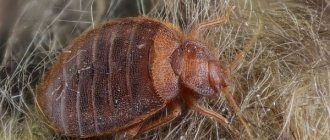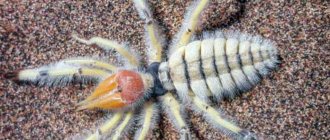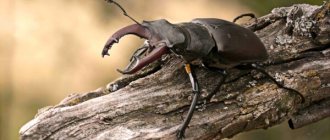Wood is an environmentally friendly, aesthetically attractive, warm material. Used in building houses, finishing, making furniture, decor. The borer beetle in the house is a real threat to wooden structures. The cunning of pests is that they penetrate deep into the wood. The adult leaves the nest only during fertilization. Standard methods of controlling insect pests are not always effective, but you can defeat the borer. What methods are used for this?
Varieties of wood-boring beetles and harmfulness
Longhorn beetleBeetle grinderBark beetleFurniture grinderBread grinder
Causes and signs of the appearance of a pest How to destroy parasites with your own hands?
- Folk recipesInsecticidesUse of dry steamFumigationMicrowavesDouchingThermal treatment
Should you seek help from specialists? Preventing the appearance of woodworm
Description of the insect
Four types of beetles live in heated rooms: furniture beetles, house beetles, grain beetles, barbel beetles, and, less commonly, bark beetles.
Characteristic features of grinder beetles:
- an elongated body (from 3 to 10 mm) of a cylindrical shape with a relatively small head; hard wings, covered with a hard chitinous shell with hairs; three pairs of five-segmented legs; antennae of different lengths; color in brownish tones with reddish, greenish-yellow shades.
Adult beetles crawl out of their nests only during the breeding season.
The main function of an adult beetle is mating and laying eggs by females. They do not live long, from one to three weeks. One female lays from 40 to 200 eggs per clutch, depending on the species. The main damage to wood is caused by larvae. From the first minute of their appearance, they begin to actively eat the tree. It takes from one to three years before pupation. During the day, the larva makes passages up to 3 mm in the tree.
Nutrition
The larvae of beetles mainly feed on cellulose in wood and paper. One of the types, bread, is found in food products: dry bread, cereals, dried fruits, pasta. Some species prefer dry wood, others wet. The population of wood grinder beetles causes significant damage to structures and wood products, literally eating it away from the inside, turning it into dust.
Life cycle and reproduction
The danger of grinder beetles is that they have a long biological life cycle, up to three years. The adult individual (imago) of the beetle grinder can be seen only in the warm season in May-June, when it gets out of the nest and mates. Caterpillars inside wood can live from three years to 15–17 years. Periodically, if the temperature fluctuates downwards, it goes into suspended animation.
Cycle:
- Eggs. The female beetle grinder lays eggs in cracks, crevices, and in nests that the female makes. They are whitish or transparent in appearance, 1–1.5 mm long. The clutch of eggs contains symbiotic microorganisms, they help the larvae digest cellulose. Larvae. They begin to appear at about 7–12 days. The shape resembles a semi-rolled white worm (3–4 mm). Most have several pairs of short, prehensile legs that help them move along the aisles. Pupa of a beetle grinder. An adult individual is formed from it in 2–3 years. Before transformation, the larva stops eating for several days. The pupa has enough accumulated nutrients.
The optimal temperature for reproduction is +28 – +30°C. If a similar temperature regime is maintained in the house, then certain types of grinder beetles can crawl out and reproduce all year round.
This is interesting. Getting rid of woodworm is difficult. All individuals of the biological chain spend most of their time inside the structures of a log house or hut.
Borer beetles can also be detected by the characteristic sound inside a wooden structure. Before mating, the male lightly hits his head against the walls of the passage. This is a conditioned signal for the female, reminiscent of the ticking of a clock mechanism.
Where does it come from?
Many owners of wooden furniture are surprised to wonder where parasites come from, because it is not easy to get into the house, and the purchased furniture was perfectly clean and smooth. It is worth noting that beetles are active only at night, because they are shy insects and can hardly be seen during the day.
It is very difficult to catch a furniture grinder: as soon as the individual senses danger, it turns over on its back and lifts its paws. This is how the parasite pretends to be dead.
It is known that grinders live in almost any home, but they are especially fond of wooden dwellings. The risk that a furniture grinder has settled in your home is much higher if the house is built entirely of wood. With the onset of spring warmth, the female beetle begins to lay eggs, from which larvae hatch, significantly spoiling the life of the owners of the house.
The larvae immediately begin to feed on wood - furniture. They chew holes and make long passages, moving randomly. With their appearance, they cause enormous damage to the property of the apartment. The life cycle of one individual larva is from 1 to 3 years. At the same time, in winter they fall into suspended animation, so that in summer they will return to active movement again.
If the room is well heated, then the larva continues to live in winter: temperature changes are detrimental to it. With stable humidity levels, individuals continue to devour furniture in large quantities. During the development process, the larvae become pupae, which will later become adult beetles aimed only at reproduction.
Furniture beetles do not infest in the following places:
- painted wood;
- lacquered furniture;
- in a clean and dry room;
- pieces of furniture affected by other parasites.
To check whether the furniture can be restored, you need to take a screwdriver and lightly pierce the area in an inconspicuous place: if the wood turns out to be dense and hard, the furniture can be saved by treating it with special compounds.
Varieties of wood-boring beetles and harmfulness
The species of grinder beetles, while fundamentally similar, differ in their preferences in food, its types, and living conditions. They also have characteristic external signs.
Longhorn beetle
Their favorite habitat is the trunks of fallen trees, mostly coniferous. Distinctive features of the imago: body length up to 3.5 cm, long whiskers up to 7 cm. Black color with a greenish tint, with whitish down on the tips of the wings. The female lays only one to three eggs, but the larva lives, develops, and sharpens wood for 3 years.
Grinder beetle
Borer beetles are shy insects. At the first sign of danger, it freezes and imitates a dead insect. For this property they are called “pretenders”. The chitinous hood and elytra are brown-red in color, body length is up to 5 mm. Borer beetles mate in late spring and early summer and can fly far from the nest.
One female makes several clutches, the number of eggs is 100–130. The larvae are 2–3 mm, voracious, destroy the tree from the inside, and make long passages in it. They sharpen wooden furniture, books, structures, and dry food. A colony of borers can cause significant damage.
Bark beetle
The name of the beetle indicates that it settles under the bark of a tree. Body length up to 5–8 mm, head elongated, almost merging with the body. Females make several clutches of 70–80 eggs per year.
If a hut or bathhouse is built of logs and there is a bark beetle infested there, then a year is enough for the structure to become unusable. When the first signs of the appearance of borer beetles are detected, it is necessary to urgently take measures to combat it. The bark must be removed from wood before it can be used as a building material.
Furniture sharpener
Chashel are small brownish bugs, 3–9 mm. The female lays up to three hundred eggs. As soon as the larva is born, it makes a small hole and goes deep into the thickness of the wood. It does not drill through holes, so at first you may not notice the appearance of grinder beetles.
The voracious caterpillars live in favorable conditions for years before turning into chrysalises. The tunnels that the shawl gnaws are filled with wood dust. They destroy any wooden structure, from wooden beams to furniture. There are two types: house and furniture.
Bread grinder
Small grinder beetles, with a body length of up to 4 mm, brownish in color. Found in all dry foods, herbs, tea, tobacco. They eat food and bugs. They are fertile, the female lays 120–140 eggs. Larvae (4–5 mm) can live for several days, and in favorable conditions for several years. The cocoon for the pupa is made from small particles of products. Small bugs fly out during the mating period; you can see them on the kitchen windowsill. If small holes appear on grocery bags, they should be thrown away along with the person possessed.
Prevention of furniture beetles
Pests cause significant damage to human property if they become infested; fighting them is long, expensive and difficult. Therefore, it is easier and more profitable to take preventive measures against their occurrence. The basis of prevention is regular ventilation of the room, thorough cleaning and keeping the wooden elements of the interior clean. “Polish” or “Losk” is perfect as a care product; their composition allows you not only to repel the grinder beetle, but also to maintain the furniture in good condition for a long time. Some wooden surfaces will be protected by regular and timely painting and varnishing. Untreated wood can be wiped with a chloramine solution or turpentine. It is recommended to rub wooden floors with mastic and turpentine. But the most reliable way is to treat surfaces with antifungal and cleaning agents.
Furniture grinders love dampness, so to prevent their occurrence, it is advisable not to store wood in damp and unventilated places.
Also, to prevent damage to wood by pests, it is necessary to treat the logs at the construction stage, using compounds such as “Phoenix”, “Pinotex”, “Senezh” and others.
Causes and signs of pest appearance
The main reason for its appearance is the use of low-quality wood that has not been treated with impregnations against borer beetles. Over time, the protective layer loses its properties. During the mating period, beetles fly to other wooden structures and make new clutches. It is necessary to periodically inspect surfaces and protect wood from woodworms. Impregnate periodically with a new layer of insecticides.
Signs of the appearance of grinder beetles:
- small holes on the surface of wooden structures, furniture; the appearance of wooden pollen, similar in color to mustard powder; rustling, tapping inside the solid wood in the evening, at night; a characteristic odor from insect secretions, insect pheromones; if you remove the outer layer, you can see grooves , larval passages.
You need to start exterminating beetles immediately, as soon as the first signs appear.
Tap the wood, the sound is different. In a healthy tree it is dull, in a damaged tree it is louder, due to the presence of voids. Pollen will begin to fall out of small tree holes.
Prevention
To prevent tree beetles from appearing in the apartment, it is necessary to carry out preventive measures. It all comes down to basic control and simple wood processing.
- Carefully select wood intended for the construction or decoration of a building.
- Impregnate wooden structures with antiseptic compounds, for example “Anti-bug”, “Wood healer” and others.
- Carefully monitor the condition of wooden products and structures during operation.
- Avoid high humidity in the room. After washing, it is advisable to dry and ventilate baths well.
- Wipe wooden surfaces with a damp sponge with a composition that includes turpentine, creolin and pre-melted paraffin.
How to destroy parasites with your own hands?
Only comprehensive measures to combat wood borers will help protect wood from destruction by wood borers.
Folk recipes
Apply when the first signs of damage by grinder beetles appear, with a limited affected area.
Methods of pest control:
- Impregnation of a wooden surface with a concentrated solution of salt. Mixtures with kerosene. Add 3 portions of turpentine to kerosene (distillation of resin secretions from coniferous trees), mix thoroughly. Lubricate the surface in areas with signs of damage. The procedure is repeated several times. Use protective equipment. The mixture is flammable, with a characteristic odor. The second method is to add kerosene to linseed motor oil (the proportion is 3 parts oil, one part kerosene), saturate a wooden surface with the mixture. Vaseline and wax. Vaseline oil is poured into the holes in the wood using a syringe, and they are sealed with wax. Disinfectant, black carbolic acid, naphthalene, and molten resin are taken in equal proportions, mixed, and applied to wooden structures. The method is more suitable for processing construction beams and boards.
Treatment with folk remedies is repeated periodically. If these methods do not give a positive result, they move on to radical methods of combating borer beetles.
Insecticides
Before you fight wood-boring beetles with insecticides, you need to protect your hands, respiratory tract, and eyes.
Conventional products, such as Dichlorvos, are ineffective in combating beetles; the aerosol ends up on the surface. Penetrates into wood in limited quantities.
Preparations:
- "Anti-bug." A complex action product that destroys not only grinder beetles, but also mold and mildew. Does not change the color of wood, therefore it is suitable for processing structural elements of furniture and lumber. Apply to the surface 2 times, with breaks until completely dry. Advantages: affordable price, low toxicity. If wood holes are found on the surface, pour the drug into them with a syringe. "Empire 20". A broad-spectrum insecticide in the form of microcapsules, which extends the period of influence on parasites to six months. Low toxicity, leaves no traces. Destroys primarily adult individuals, interrupting the reproduction cycle. The best time for processing is May-June, the mating period of grinder beetles. Spray and wet the contaminated surface. "Treetox." A drug for year-round use. Prolonged exposure (up to six months). The tree is treated 3 times, with an interval of 21 days. Lubricate wooden surfaces, insert a syringe into the holes made by the beetles, and seal them with wax. "Lingofix I-pro." A new generation of means to combat borers affects the reproduction of insects and affects their growth. Can be processed at any time of the year. It is recommended to disinfect wooden exterior parts after 10 years. One portion of Lingofix I-Pro is diluted in three parts of water before use. After processing and complete drying of the preparation, the surface can be opened with stain, varnish, or paint. In conditions of severe damage to wood, it is injected into holes on the surface. Or drill diagonal holes with a thin drill and pour the diluted drug into it. "Belinka belocid." A combined product made from a mixture of alkyd resins and biocides. It is toxic, so spraying is not recommended. Does not change the color of wooden coverings. Used as a prophylactic to protect against the borer beetle. In order to sanitize the affected areas, treat the surface several times and inject it into the wood holes with a syringe. Allow the wood to dry for a week, then repeat the treatment.
Application of dry steam
In a bathhouse or sauna, dry steam is obtained by heating the heater stove to 600–700°C. If you pour water on a hot stove, dry steam is formed. Heating a room with dry steam to a temperature of 85–90°C leads to the death of pests.
Fumigation
Method of fumigating a room with PH3 (hydrogen phosphide). For these purposes, special equipment is required, so it is right to entrust the processing to professionals. The gas is toxic, protective equipment is required. Fumigation is a highly effective remedy that penetrates into all cracks and holes, destroying the entire population of grinder beetles. Treatment lasts 24 hours, ventilation – 2 days.
The second method is fumigation using sulfur bombs (“Pawn-B”). It is better to poison the beetle grinder during the breeding season in May–June.
Microwave
A professional way to exterminate bark beetles. Using a microwave generator, the damaged surface is treated. At temperatures above 60°C, the entire population of grinder beetles dies. The advantage is targeted impact, high efficiency.
Douching
The douching method is based on the introduction of insecticides into the holes made by grinder beetles. In case of deep damage, additional holes are made with a thin drill. After processing, they are sealed with wax.
Heat treatment
The best remedy for woodworms in a wooden house is to freeze it to at least –3°C. The beetle and larvae die at sub-zero temperatures. A good way to control pests in a bathhouse.
Heat the structural elements with a construction hairdryer to a temperature of +45°С ... – 50°С. The larvae and eggs of the borer beetle die.
Struggle
Now let's look at how to deal with tree beetles if they do appear in your home. For minor lesions, several simple methods are used.
- Vaseline oil. It is poured into a syringe and injected into the holes left by the beetle. After filling the passages, you can seal the holes with paraffin or window putty.
- The second composition option: mix three parts of turpentine with one part of kerosene.
- Naphthalene dissolved in gasoline will also leave the beetles no chance of survival.
- Warming up a wooden product to a temperature above 60 degrees.
- Freezing to -2.
If wooden structures are severely damaged, such actions are unlikely to save them. Imagine how many syringes need to be pumped in case of total damage to the walls of a house, for example. In this case, more effective remedies for wood beetles work. Such methods are also applicable on large, industrial scales.
- Preparations are applied to the wood with a brush. Among them we can note such as: “Karbofos”, “Funanon”, “Paragraph” and many others.
- To get rid of tree beetles forever, fumigation of the interior space is used. It is carried out by spraying phosphine gas followed by ventilation. Individual pieces of furniture can be placed in a large plastic bag and then filled with the same product.
- Microwave radiation. Devices with an effect similar to that used in a home microwave are used to treat the wooden walls of buildings, and instead of products you will have boiled wood bugs.
Attention! All types of treatments are best carried out between the beginning of May and mid-June. It is at this time that adults emerge from the pupae. After they eat poisoned wood, their ability to procreate ceases to exist.
We present a video about a new drug that is designed to combat tree beetles:
Pretending
Grinders can be found everywhere. Rare species settle in the cones of conifers or stems of herbaceous plants; the majority choose dead dry wood and tree fungi for settlement. In total, over 1,700 different species are known; only about a hundred live in Russia. The three most common types are:
Particularly interesting is the subfamily of grinders - pretenders (Anobiidae Ptininae). These small bugs, sensing danger, skillfully pretend to be dead, freezing motionless and pressing their legs and antennae tightly to their body. A stationary insect is difficult to distinguish from dry debris. About three hundred species of pretenders have been described, 35 species are common in the Russian Federation.
The name of the family reflects the characteristic feature of these insects. Most grinders are serious technical pests; they grind and turn everything into dust. Having settled in a house, grinder beetles destroy wooden walls, beams, floors, furniture, food products, medicinal raw materials, books, herbariums, insect collections and even fur. Actually, the main damage to the farm is caused not by the beetles themselves, but by their larvae. The life of an adult beetle lasts only two weeks, during which the insect is predominantly nocturnal.
and eats absolutely nothing. The main purpose of this two-week existence, for which the young beetle leaves its arboreal home at the beginning of summer, is mating in the name of procreation. After mating, females lay eggs in cracks and crevices of wooden surfaces.
After a couple of weeks, the larvae hatch from the eggs and begin their destructive work. Gnawing winding passages in the wood, they pass kilograms of raw materials through their intestines. Since the development of the larva can last up to five years, it manages to work hard during this time, leaving behind complete destruction. The larvae live in the deep layers of wood, so their activity on the surface is completely unnoticeable. And only in the silence of the night can you hear characteristic sounds reminiscent of the quiet ticking of a clock - this is the work of voracious and hardworking caterpillars. The larva that has reached maturity pupates, and two weeks later the young beetle flies out into the world to repeat everything all over again.











